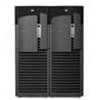
The new sales record is different from the buying spree on which companies embarked at the turn of the millennium, when they loaded up on low-cost industry standard servers.
The IDC report indicated that revenue growth in mid-range and high-end servers outpaced growth of volume systems for the first time in 10 years.
Matthew Eastwood, programme vice president at IDC's Worldwide Server Group, attributed the shift in buying patterns to the increasing adoption of virtualisation.
"It is clear that large and small organisations across the world are investing aggressively to simplify and virtualise their IT infrastructures," he said in a statement.
"For the first time in more than 10 years average selling values in the quarter increased year over year as IT managers moved to consolidate IT workloads.
"This shift towards a shared compute infrastructure is driving additional scalability, memory attachment, and I/O needs, which in turn, lead to higher average selling values.
"For technology suppliers, this inflection point represents an opportunity for the vendors best equipped to innovate their systems, software and services offerings and meet these challenges."
The IDC report tracks sales of all server architectures, including x86, Intel's Itanium, Sun Microsystems' Sparc servers as well as IBM's Power and mainframe systems.
IBM claimed 32.8 percent of all 2006 server revenues, trailed by HP with 27.2 percent. Sun practically tied with Dell for third and fourth place at 10.8 and 10.3 percent respectively.
But at 15.4 per cent revenue growth, Sun is quickly outgrowing Dell's 2.2 percent.
Sun has bounced back from its post-dotcom bubble sales slump in the past few quarters after the introduction of its Niagara processor and new systems powered by x86 processors.
All system architectures and operating systems demonstrated growth, with a special bright spot for Itanium systems.
The oft-criticised chip generated more than US$1bn in a single quarter for the first time late last year. Sales grew by 71.5 percent year-over-year.
The blade server market is also picking up steam, growing at a rate of 18.2 percent year-over-year. HP is starting to challenge IBM's dominance in the blade segment.
IBM remained the top seller with a 40 percent market share relative to HP's 37.4 percent, but the latter surpassed Big Blue's sales in the last quarter by a 13.2 percent margin.
HP unveiled its c-Class blade system last year which is considered a third-generation blade design.
IBM is still selling second-generation blade technology. IDC attributed HP's rise to the appeal of the c-Class system.




.png&h=140&w=231&c=1&s=0)



_(26).jpg&w=100&c=1&s=0)

 iTnews Executive Retreat - Security Leaders Edition
iTnews Executive Retreat - Security Leaders Edition










_(1).jpg&h=140&w=231&c=1&s=0)



